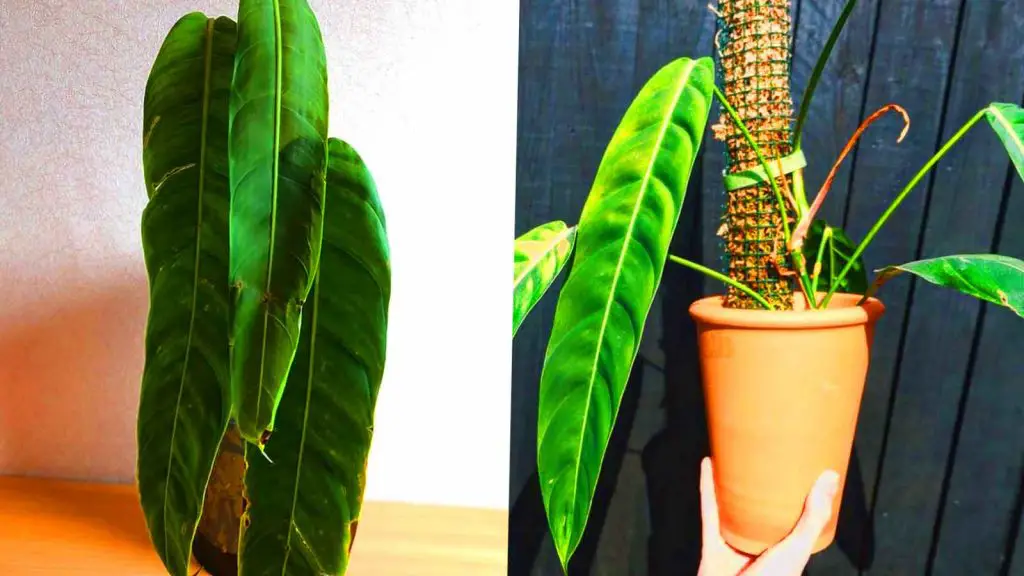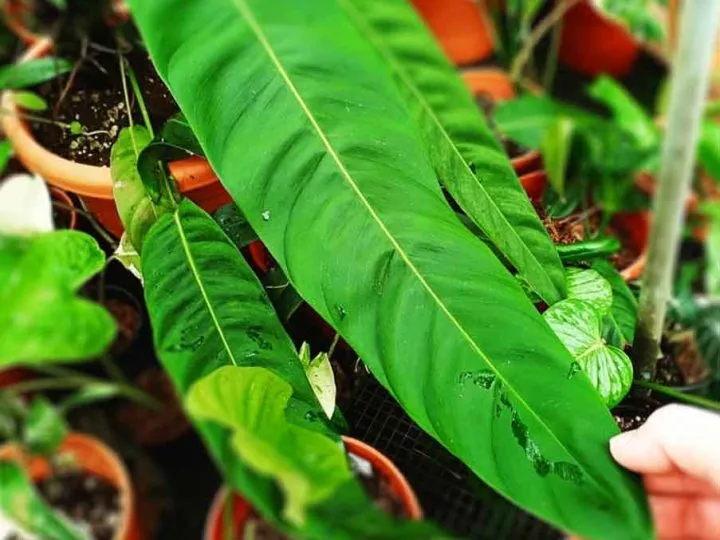
Philodendron Patriciae Care
To care for this tropical philodendron you will need a medium amount of bright light. The soil should be moisture-retaining but also have good drainage. For optimal growth, you need to mimic its original conditions. Philodendron Patriciae will need high humidity for larger leaves. You need to fertilize for good plant care. Water this plant when the topsoil is dry, and keep temperatures somewhat warm.
Brief History of philodendron Patriciae
This philodendron was first documented in 1979. During this time rainforests were explored for rare plants by botanists from the U.S. It has been documented to exist in many countries in South America. It is in the highest amounts in Columbia.
Around the late 1980s, many tried to cultivate this plant outside of South America. It was very niche and difficult to cultivate, so its popularity was not high. In the late 90s and early 2000s, certain Patriciae were grown that were resilient and could survive better. After this point, the plant became more common. In the internet age, many growers are cultivating and selling this plant. Unfortunately, its popularity is higher than supply, so prices are high. This is a plant that will typically grow well.
Quick run though
| Light requirements | Medium amounts of indirect sunlight. |
| Watering | Allow the top 1-2 inches of soil dry out before watering again. |
| Soil | Use a substrate with high water retention and drainage. Coco Peat and perlite are good. |
| Temperature | Hot temperatures are best. Room temperature is good enough but avoid freezing temperatures. |
| Humidity | High humidity is important for HUGE leaves. Normal humidity is good enough. |
| Fertilizer | You should use fertilizer once a month during spring and summer. |
| Propagation | You can use water propagation or soil propagation. |
| Size/Growth | The leaves will grow to over 48 inches under optimal conditions. |
Lighting
Filtered, bright but indirect light is best for this plant. It requires medium to high amounts of light. The ideal lighting is between 600 and 1000 foot candles. Between this interval, the plant will grow at a rapid pace. It is also here that the leaves will produce the best color. They will grow vivid dark leaves under optimal conditions.
Plant lovers should be aware that excessive amounts of light will bleach the leaves. Try placing your plant in direct sunlight, or give it above 1500 ft so see the effects. This plant has always grown near the bottom of the forests in Columbia, where they don t see much direct sunlight.
It is up to yourself if you want to grow this plant near a window, or with artificial light. We support using natural light for as many of your plants as possible. We like to stay natural for the most part.
Direct sunlight will denature many enzymes in the plant cell walls. Impaired function leads to brown or pale leaves. The leaves become brittle as water evaporation dries out the leaves. So it is important to place it away from direct sunlight.
If you are unsure if the plant is getting too much, or too little sunlight, get a light measurer. A Foot candle/lux meter can be found on Amazon for about $20-$60. We recommend getting one, to test in the summer and winter.
This plant will grow slower in the winter months. This is because light, temperature, and humidity are lower. Their native environment in the rainforests is much more consistent.
In optimal conditions, this plant will grow all year round
Watering requirements for Patriciae
Many think philodendrons should be watered a lot since they come from rainforests, but they can easily be overwatered. You should water this plant about once per week. It is best to check if the soil ended watering instead of following a schedule. The top half of the soil should be dry before watering.
Make sure to remember to water more often in the summer. Also, water more often if the plant is exposed to excessive sunlight. High temperatures and sunlight will evaporate water faster.
The Patriciae philodendron likes hard water with a lot of calcium. Growers that use tap water with moderate hardness will find their plants will grow a whole lot.
If you water this plant too much, the roots will rot. Overwatering also cuts off the roots from vital oxygen. So, make sure the top 1 inch of the soil is dry before watering again.
Soil and substrate
For this plant, you will need soil/substrate with good water retention. At the same time, the soil should also be very well-draining.
Professional Patriciae growers use cocopeat with 10% perlite and 10% orchid bark.
Get a pot that well with draining excess water. If excess water stays in the pot and soil, there will be a whole host of problems. For your sanity’s sake and the plant’s health, get some well-draining soil for all your philodendrons.
Make the plant feel at home. The rainforests of South America have moist and fluffy soil.
Sandy soil can cause starvation, whilst compact soil doesn’t drain well enough.
Temperature
Fortunately, this tropical plant has shown very good resilience and tolerance to lower temperatures. You should avoid keeping this plant under 40F/7 celsius, though it will survive this temperature without a doubt. 14-33°C/61-92°F is the ideal temperature for this plant. This temperature mimics the natural conditions Patriciae has evolved in.
When it becomes summer or winter, you might wanna put the plant inside, according to where you live. If frost happens often, then keep it inside during winter. In desert climates, you should keep the plant inside during the summer. Excessive temperatures and sunlight will evaporate its water content. Turning it pale, and making it susceptible to bacterial attacks.
Indoor temperatures should be sufficient all year long. The growers keeping the plant inside all year in a living room/office will usually have smaller leaves. To get huge long leaves, you need higher temperatures and more humidity.
Humidity needs
The amount of humidity depends on what you are trying to achieve. If you want huge long leaves, then you need to keep the plant humid. If your goal is to simply keep the plant alive and healthy, then you do not have to worry about humidity.
A plant grown with higher humidity have shiny leaves. To increase humidity, try to mist the leaves often. You can also keep a bucket of water nearby. The results will be great, but the best results come from having a greenhouse or living in a tropical climate.
The best humidity level for huge healthy leaves is around 70%.

Fertilizer for Philodendron Patriciae
The philodendorn patriciae likes to eat. You should feed the plant a balanced diet, once a month during spring and summer. You don’t have to be too specific with the fertilizer. Use an all-purpose fertilizer to feed the plant. It is also a good idea to add some extra supplementary calcium if you use filtered water. It is not a needed step if you use hard tap water.
Try to hit a pH of 5-6 for the soil and fertilizer. If your plant isn’t growing fast even with fertilizer, this could be your problem.
Pruning and maintenance
Pruning is not only removing bad or damaged leaves. You should use pruning as a tool to encourage growth and longevity. Don’t simply remove bad parts, but also parts that could stunt growth.
Leaves, stems, and random shoots can be intertangled or intrusive. Cut these parts off. This will leave your philodendron healthier in the long run, even if you have to remove large parts.
Use sanitized pruners, clippers, or scissors for pruning. You don’t want to spread disease, especially from another plant in your collection.
You should place the plant somewhere with enough space. The Patriciae likes being well ventilated. It is also a good idea to keep the plant somewhat high from the ground. It will have better ventilation and more space for the leaves to drop.
Propagation
We like the idea of propagating plants. It is a great inexpensive way to create a daughter plant from the mother philodendron. In the plant world there a quite a few creative ways to propagate plants. The philodendron patriciae is propagated through cuttings of the stem.
You can grow these cutting either through the water method or the soil method. We prefer the soil method, as the water method can become filled with bacteria if you aren’t sanitized enough.
Water propagation:
Many see great results from water propagation. It’s the easiest method, as you just need water.
- Use a sanitized pruner/cutting tool.
- Have 1-5 leaves on the cutting
- Cut about 1-2 cm below a node. The preferred node has some aerial roots.
- Place the cutting in a transparent container of CLEAN water
- Roots should come from the node. Once roots are long enough, place the plant in well-draining soil.
- Keep the soil at a tropical temperature to keep the cutting alive.
Soil propagation
- Find a nice branch or stem.
- There should be 1-5 leaves on the cutting
- Cut with a sanitized tool
- Make an angled cut 1-2 cm below a node
- Dip the bottom in a rotting hormone.
- Place the cutting in moist well-draining soil
- You should see results within 1-3 weeks
- Keep the plant at a consistently warm temperature
Growth and size for Philodendron Patriciae
The philodendron Patriciae will grow huge leaves in optimal conditions. The leaves can grow to over 48 inches /1.25 meters in length. And up to 11”/28 cm wide in large healthy plants. Patriciae kept in a normal room, will typically only grow leaves up to 30 inches /75 cm long. This is because larger leaves come with better humidity and ventilation. Leaves will last well over 3 years in healthy plants.
They can grow to a huge 30 feet long in good climates.
The stems of healthy mature plants will grow to 18 inches / 45 cm thick within 7 years of optimal growth.


Sterling Mccullough
Sunday 6th of August 2023
The article has actually peaks my interest.
Layton Zhang
Monday 31st of July 2023
Nice post.